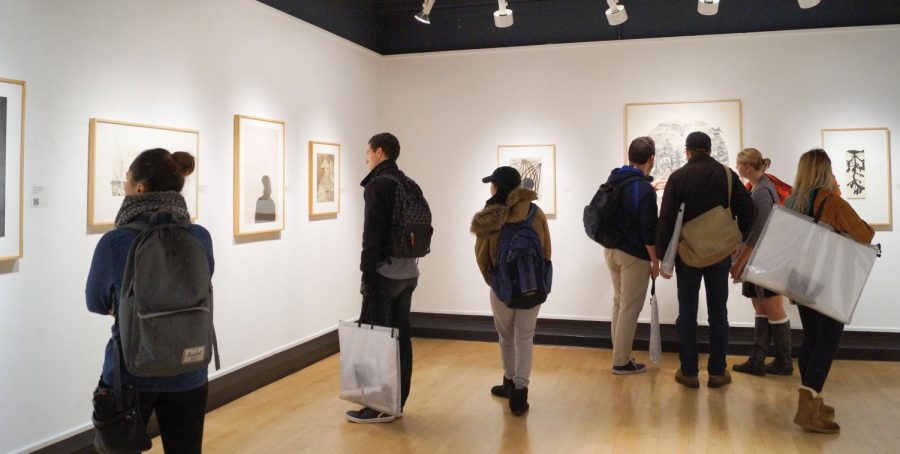Fairbanks arts gallery highlights Japanese print artists
November 23, 2015
For Yuji Hiratsuka, a professor of art at OSU and artist himself, printmaking brings inevitable frustrations but an even greater sense of joy “This is my therapy,” he said. “I don’t need a therapist – I just make art and I am happy.”
When he creates a print he follows his intuition and establishes a timeline to guide himself. Hiratsuka said that fixing mistakes is a part of the process. He has chosen this path because clients do not dictate the vision he has in mind. He also enjoys watching students develop as they try something new.
“We don’t dictate much. I try to expose what I know, my knowledge about this medium, and then they learn and create their own. Sometimes I even learn from them. It’s a back-and-forth that we do,” Hiratsuka said.
Born in Japan, Hiratsuka began his personal practice of printmaking many years ago. He received his B.S. in art education in Tokyo, then came to the US in 1985 to attain a graduate degree. He has been teaching art classes at OSU since 1992.
Understandably, he was a model candidate to speak at the Contemporary Japanese Art Prints opening reception that was held at the Fairbanks Art Gallery Nov. 19. Douglas Russell, the art gallery director at Fairbanks, called Hiratsuka his “favorite artist and Japanese printmaker of all time”.
Located on campus, Fairbanks Hall serves as a place for education in its classrooms as well as a source of inspiration from its gallery. “Our first priority is to serve the students and our second priority is to serve the community,” Russell said.
Currently displayed is an exhibit that features artwork produced from the many styles of printmaking. Techniques include woodprint, etching, engraving, mezzotint, aquatint, drypoint and lithography, to name a few.
During his talk, Hiratsuka noted that he had actually worked alongside a few of the artists featured in this gallery decades ago in Japan. When comparing the work of Japanese artists to the work he has seen in the West, he called to mind some distinctive differences. Japanese artists “rely on the process a lot,” while “Americans work more intuitively, sometimes with less technique, free from those restrictions,” he noted. The trend of Japanese print borders traditionalism, and in Hiratsuka’s experience, Western artists have an air of innovativeness.
When taking into account the process – one that is highly meticulous and detail oriented – it is reasonable that the approach to the methods vary. Traditionally in printmaking, perfection is strived for and the most important focus is to keep the process neat. Some who are naturally inclined towards technical work enjoy etching for this reason. This is the case for senior in art history Alisa Vernon.
Vernon’s interests have also expanded to the business side of things such as gallery work and museum curation. In her Exhibition Design II class she works with her peers alongside Russell to set up all of the prints in the gallery and decide where they should be placed.
“Designing a space is just as creative as working on a plate or drawing because you have to figure out what goes together, what doesn’t, and how your eye flows through the space,” Vernon said. Vernon’s plans for the future are to apply to an arts administration program for graduate school.
Kyle Ellis, a senior in fine arts with a focus in printmaking, was one of the 70 people that trafficked through the gallery Nov. 19. He found inspiration from seeing artists who have made careers out of the same medium that he has chosen as his own focus.
When reflecting on his experiences within the art community of OSU, he commented, “The art professionals around here are very welcoming and they are going to do what is best for you.” Although this line of work requires extensive time in the studio, he expressed his appreciation for spending that time around others who are passionate about the same things.
The arts department at OSU offers many resources for students with an interest in printmaking. One opportunity to have artwork published is the Cascade Print Exchange. Every year, a book is compiled with submissions from students of OSU in addition to other printmakers across the US and internationally. This year’s submissions are due Jan. 31.
Educational funding is available every year through the Norma Seibert Printmaking Scholarship. This program has been at OSU for the past 30 years.
For those who have never tried printmaking – do not be daunted. Hiratsuka said that, “everyone can learn, it just takes patience.”
Cascades Hall, part of the College of Liberal Arts, will be having an open house on Dec. 4 from 12 p.m. to 4 p.m. There will be demonstrations as well as a showcase of the artwork that students have produced this term.
Contemporary Japanese Art Prints will be displayed in the Fairbanks Gallery until Dec. 1. The gallery is free and open Monday through Friday 8 a.m. to 5 p.m. Different artists are rotated as well as featured student collections in West Gallery, a smaller room located inside.











































































































